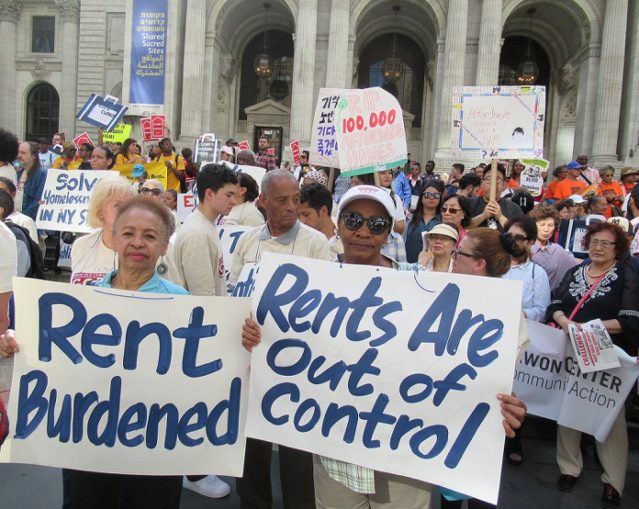Housing is a right
Even as the stock market and profits soar, so does the cost of housing in the United States. A transformation has been taking place in major cities — San Francisco, Philadelphia, Washington, D.C., and New York are but a few examples — as affordable rental housing is either demolished altogether or renovated to provide luxury co-ops and condos for the newly rich and/or the established rich, who are either moving in from the suburbs or enjoy residences in both city and country.
The election of a president whose personal fortune comes from real estate, even as he claims to care about workers’ jobs, has only accelerated the process.
Tenant organizations are fighting a tide of wealth that is threatening to suck them under.
And growing wealth exists alongside growing poverty. But not because poor people are “too lazy to work.” Just the opposite. According to the National Coalition for the Homeless, back in 2009 as many as 44 percent of the homeless had jobs — but the pay was so low they couldn’t afford even the cheapest housing. Since then, it’s only gotten worse.
That same year, the National Low Income Housing Coalition figured that a minimum-wage worker “would have to work 87 hours each week to afford a two-bedroom apartment at 30 percent of his or her income, which is the federal definition of affordable housing.”
Working 87 hours each week! That’s more than TWICE the 40-hour week, which once was the standard. Does anyone remember what it was like to work eight hours, sleep eight hours, live a life for eight hours and be able to do things you enjoy on the weekends?
To work 87 hours a week, you’d have to toil 16 hours each weekday, which means sleep five hours, have three hours to travel to and from your jobs and catch some food on the fly, then work those additional seven hours on Saturday — and collapse on Sunday. Unless you’re scheduled to work then, which is increasingly likely, especially in low-wage retail and food service jobs.
It is no wonder that homelessness is growing, alongside obscene wealth at the top.
What happens to those displaced? A survey in 2017 showed that on any given night in this rich country, more than half a million people — 544,000 — were homeless, with nowhere to sleep but under bridges, in back alleys or in crowded homeless shelters.
Many women with children are homeless, some to escape abuse. So are people with physical, mental and emotional disabilities. And because being homeless only exacerbates these conditions, many end up in hospital emergency rooms.
Beginning a century and a half ago, the development of capitalism and the triumph of large-scale manufacture over cottage industries in much of Europe and North America enormously increased the productivity of labor. One worker today can produce a hundred times as much — whether it’s textiles or steel or houses — with the new technology. A partially prefabricated, nicely designed four-bedroom house today can be assembled and finished in one month.
That’s the upside of capitalist development. The downside of an economic system built on profits and exploited labor is the total degradation of the life of the worker.
Frederick Engels, Karl Marx’s closest collaborator, wrote in 1872 about how the bourgeoisie solves the housing question:
“The breeding places of disease, the infamous holes and cellars in which the capitalist mode of production confines our workers night after night, are not abolished; they are merely shifted elsewhere! … As long as the capitalist mode of production continues to exist, it is folly to hope for an isolated solution of the housing question or of any other social question affecting the fate of the workers.
“The solution lies in the abolition of the capitalist mode of production and the appropriation of all the means of life and labor by the working class itself.”
Amen, Comrade Freddy.


